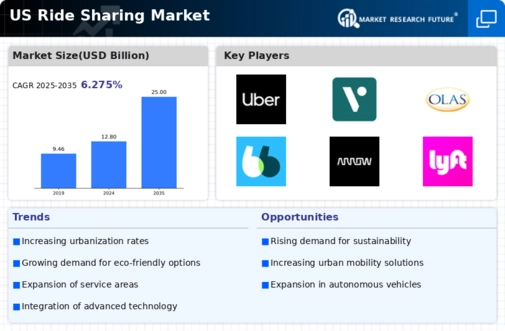Urbanization and Population Density
The increasing trend of urbanization in the United States is a pivotal driver for the ride sharing market. As more individuals migrate to urban areas, the demand for efficient transportation solutions rises. In densely populated cities, traditional car ownership becomes less practical due to limited parking and high maintenance costs. Consequently, the ride sharing market experiences growth as it offers a convenient alternative. According to recent data, urban areas account for approximately 80% of the US population, which correlates with a higher utilization of ride sharing services. This demographic shift suggests that the ride sharing market will continue to thrive as urban centers expand and the need for flexible transportation options increases.
Cost-Effectiveness and Affordability
Cost considerations play a significant role in shaping the ride sharing market. Many consumers view ride sharing as a more economical option compared to owning a vehicle, especially in urban settings where expenses such as insurance, fuel, and maintenance can accumulate. The average cost of owning a car in the US is estimated to be around $9,000 annually, while ride sharing services often provide more affordable alternatives. This financial incentive encourages users to opt for ride sharing, particularly among younger demographics who may prioritize budget-friendly options. As the ride sharing market continues to evolve, the emphasis on cost-effectiveness is likely to attract a broader user base, further driving market growth.
Regulatory Environment and Policy Support
The regulatory landscape significantly impacts the ride sharing market. In recent years, various states and municipalities have implemented policies that either support or restrict ride sharing operations. Favorable regulations, such as reduced licensing fees and simplified operational requirements, can stimulate market growth by encouraging new entrants and expanding service offerings. Conversely, stringent regulations may hinder market expansion. The ride sharing market benefits from ongoing dialogues between industry stakeholders and policymakers, which aim to create a balanced regulatory framework. As the industry matures, the evolving regulatory environment will likely play a critical role in shaping the future trajectory of the ride sharing market.
Environmental Awareness and Sustainability
Growing environmental consciousness among consumers is increasingly influencing the ride sharing market. As awareness of climate change and pollution rises, many individuals seek sustainable transportation options. Ride sharing services, particularly those integrating electric vehicles, align with this shift towards eco-friendliness. The ride sharing market is responding to this demand by promoting carpooling and electric vehicle options, which can significantly reduce carbon footprints. Data indicates that ride sharing can decrease the number of vehicles on the road, potentially leading to a reduction in greenhouse gas emissions. This alignment with sustainability goals positions the ride sharing market favorably in the eyes of environmentally conscious consumers, likely enhancing its appeal and market share.
Technological Integration and User Experience
The integration of advanced technology is a crucial driver for the ride sharing market. Innovations such as mobile applications, GPS tracking, and real-time data analytics enhance user experience and operational efficiency. These technologies facilitate seamless ride booking, tracking, and payment processes, making ride sharing more accessible and user-friendly. Furthermore, the rise of artificial intelligence and machine learning in optimizing routes and matching drivers with passengers contributes to improved service quality. As technology continues to evolve, the ride sharing market is expected to leverage these advancements to attract and retain users, thereby fostering growth and competitiveness in the industry.

















Leave a Comment